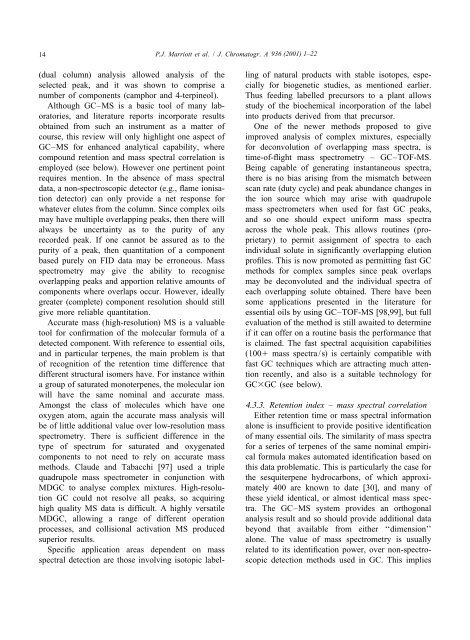Gas chromatographic technologies for the analysis of essential oils
Gas chromatographic technologies for the analysis of essential oils
Gas chromatographic technologies for the analysis of essential oils
You also want an ePaper? Increase the reach of your titles
YUMPU automatically turns print PDFs into web optimized ePapers that Google loves.
14 P.J. Marriott et al. / J. Chromatogr. A 936 (2001) 1–22<br />
(dual column) <strong>analysis</strong> allowed <strong>analysis</strong> <strong>of</strong> <strong>the</strong> ling <strong>of</strong> natural products with stable isotopes, espeselected<br />
peak, and it was shown to comprise a cially <strong>for</strong> biogenetic studies, as mentioned earlier.<br />
number <strong>of</strong> components (camphor and 4-terpineol). Thus feeding labelled precursors to a plant allows<br />
Although GC–MS is a basic tool <strong>of</strong> many lab- study <strong>of</strong> <strong>the</strong> biochemical incorporation <strong>of</strong> <strong>the</strong> label<br />
oratories, and literature reports incorporate results into products derived from that precursor.<br />
obtained from such an instrument as a matter <strong>of</strong> One <strong>of</strong> <strong>the</strong> newer methods proposed to give<br />
course, this review will only highlight one aspect <strong>of</strong> improved <strong>analysis</strong> <strong>of</strong> complex mixtures, especially<br />
GC–MS <strong>for</strong> enhanced analytical capability, where <strong>for</strong> deconvolution <strong>of</strong> overlapping mass spectra, is<br />
compound retention and mass spectral correlation is time-<strong>of</strong>-flight mass spectrometry – GC–TOF-MS.<br />
employed (see below). However one pertinent point Being capable <strong>of</strong> generating instantaneous spectra,<br />
requires mention. In <strong>the</strong> absence <strong>of</strong> mass spectral <strong>the</strong>re is no bias arising from <strong>the</strong> mismatch between<br />
data, a non-spectroscopic detector (e.g., flame ionisa- scan rate (duty cycle) and peak abundance changes in<br />
tion detector) can only provide a net response <strong>for</strong> <strong>the</strong> ion source which may arise with quadrupole<br />
whatever elutes from <strong>the</strong> column. Since complex <strong>oils</strong> mass spectrometers when used <strong>for</strong> fast GC peaks,<br />
may have multiple overlapping peaks, <strong>the</strong>n <strong>the</strong>re will and so one should expect uni<strong>for</strong>m mass spectra<br />
always be uncertainty as to <strong>the</strong> purity <strong>of</strong> any across <strong>the</strong> whole peak. This allows routines (prorecorded<br />
peak. If one cannot be assured as to <strong>the</strong> prietary) to permit assignment <strong>of</strong> spectra to each<br />
purity <strong>of</strong> a peak, <strong>the</strong>n quantitation <strong>of</strong> a component individual solute in significantly overlapping elution<br />
based purely on FID data may be erroneous. Mass pr<strong>of</strong>iles. This is now promoted as permitting fast GC<br />
spectrometry may give <strong>the</strong> ability to recognise methods <strong>for</strong> complex samples since peak overlaps<br />
overlapping peaks and apportion relative amounts <strong>of</strong> may be deconvoluted and <strong>the</strong> individual spectra <strong>of</strong><br />
components where overlaps occur. However, ideally each overlapping solute obtained. There have been<br />
greater (complete) component resolution should still some applications presented in <strong>the</strong> literature <strong>for</strong><br />
give more reliable quantitation.<br />
<strong>essential</strong> <strong>oils</strong> by using GC–TOF-MS [98,99], but full<br />
Accurate mass (high-resolution) MS is a valuable evaluation <strong>of</strong> <strong>the</strong> method is still awaited to determine<br />
tool <strong>for</strong> confirmation <strong>of</strong> <strong>the</strong> molecular <strong>for</strong>mula <strong>of</strong> a if it can <strong>of</strong>fer on a routine basis <strong>the</strong> per<strong>for</strong>mance that<br />
detected component. With reference to <strong>essential</strong> <strong>oils</strong>, is claimed. The fast spectral acquisition capabilities<br />
and in particular terpenes, <strong>the</strong> main problem is that (1001 mass spectra/s) is certainly compatible with<br />
<strong>of</strong> recognition <strong>of</strong> <strong>the</strong> retention time difference that fast GC techniques which are attracting much attendifferent<br />
structural isomers have. For instance within tion recently, and also is a suitable technology <strong>for</strong><br />
a group <strong>of</strong> saturated monoterpenes, <strong>the</strong> molecular ion GC3GC (see below).<br />
will have <strong>the</strong> same nominal and accurate mass.<br />
Amongst <strong>the</strong> class <strong>of</strong> molecules which have one 4.3.3. Retention index – mass spectral correlation<br />
oxygen atom, again <strong>the</strong> accurate mass <strong>analysis</strong> will Ei<strong>the</strong>r retention time or mass spectral in<strong>for</strong>mation<br />
be <strong>of</strong> little additional value over low-resolution mass alone is insufficient to provide positive identification<br />
spectrometry. There is sufficient difference in <strong>the</strong> <strong>of</strong> many <strong>essential</strong> <strong>oils</strong>. The similarity <strong>of</strong> mass spectra<br />
type <strong>of</strong> spectrum <strong>for</strong> saturated and oxygenated <strong>for</strong> a series <strong>of</strong> terpenes <strong>of</strong> <strong>the</strong> same nominal empiricomponents<br />
to not need to rely on accurate mass cal <strong>for</strong>mula makes automated identification based on<br />
methods. Claude and Tabacchi [97] used a triple this data problematic. This is particularly <strong>the</strong> case <strong>for</strong><br />
quadrupole mass spectrometer in conjunction with <strong>the</strong> sesquiterpene hydrocarbons, <strong>of</strong> which approxi-<br />
MDGC to analyse complex mixtures. High-resolu- mately 400 are known to date [30], and many <strong>of</strong><br />
tion GC could not resolve all peaks, so acquiring <strong>the</strong>se yield identical, or almost identical mass spechigh<br />
quality MS data is difficult. A highly versatile tra. The GC–MS system provides an orthogonal<br />
MDGC, allowing a range <strong>of</strong> different operation <strong>analysis</strong> result and so should provide additional data<br />
processes, and collisional activation MS produced beyond that available from ei<strong>the</strong>r ‘‘dimension’’<br />
superior results.<br />
alone. The value <strong>of</strong> mass spectrometry is usually<br />
Specific application areas dependent on mass related to its identification power, over non-spectrospectral<br />
detection are those involving isotopic label- scopic detection methods used in GC. This implies











![Bericht von Schimmel & Co. [Inhaber Gebr. Fritzsche] in Leipzig](https://img.yumpu.com/24438150/1/171x260/bericht-von-schimmel-co-inhaber-gebr-fritzsche-in-leipzig.jpg?quality=85)




